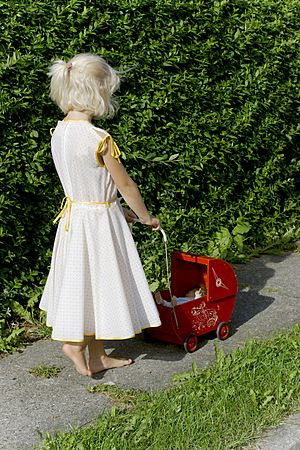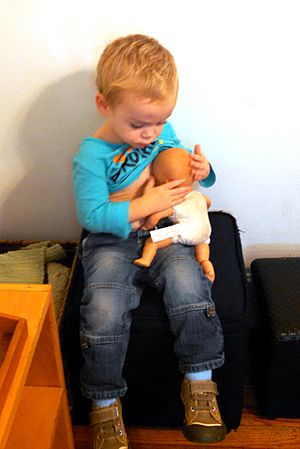Make believe facts for kids
Make believe, also known as pretend play, is a fun and creative way to play. It's different from daily tasks because it's all about imagination. Kids use make believe for many reasons. It helps them safely show their feelings and wishes. When children pretend, they use and strengthen what they already know. Kids who are good at pretend play often have better social skills. They also think better and can understand how others feel.
For something to be pretend play, you must know it's not real. You have to understand the difference between what's real and what's make believe. If you think your pretend world is actually real, then you're not pretending. Pretend play can involve actions, or it can just be in your mind.
Contents
When Does Pretend Play Start?
Pretending seems to be something we are born with. It starts early, usually between 18 and 24 months old. Kids pretend more often between 1 and 2.5 years of age. The first type of pretend play often involves using one object for another. By age 3, children can easily tell the difference between real life and pretend.
Kids aged 3 to 6 who are used to pretend play start playing together more. They give dolls or toys more active roles. For example, a doll might "drive a car" instead of just being "fed." At age three, pretend play is often very close to real life. A three-year-old girl might pretend to go grocery shopping with her mom. Both her role and the activity are very real.
Between ages 4 and 5, kids get better at role-playing. By age five, they can include different types of relationships in their play. They can be a parent, a spouse, or even a police officer or doctor.
What Makes Up Pretend Play?
Role-Play
When kids role-play, they act like someone else. This means showing both how someone looks and how they might feel inside. When children role-play with others, it's called sociodramatic play. This type of play usually starts around age three. It might even start earlier for kids with older brothers or sisters.
At first, sociodramatic play follows strict rules. Kids stick to known roles and play side-by-side more than together. By age 5, children start to be more creative with their roles. They add more imagination and build on what their play partners create.
Role-play comes in three main types:
- Relational role-play is based on relationships kids see or experience. Examples include mother and child, or husband and wife.
- Functional role-play focuses on the jobs and actions a character usually does.
- Character role-play shows typical features of a character. These are often based on how society sees them.
Pretend play is great because it doesn't need special toys. All a child needs is their imagination. This means kids from all backgrounds can develop important skills. Pretend play helps kids learn things that might otherwise need expensive educational toys.
More complex role-play involves understanding what another person might be thinking. This skill usually appears around age 5. It helps kids improve their social skills. They learn to see things from another person's view. This helps them understand and work with others.
Nonliteral Actions
There are five common behaviors in pretend play that show it's not real.
- Doing a task without the right tool. For example, pretending to call someone without a real phone.
- Using one object to stand for another. Like using a block as a phone.
- Taking on a role and doing what that character would do. For example, pretending to be a firefighter putting out a fire.
- An action leading to an unrealistic result. Like pretending to clean a room just by snapping your fingers.
- Giving lifelike qualities to an object that isn't alive. For example, making a doll talk or drink tea.
It's important for kids to always know that pretend play is separate from the real world. They must understand that changes made during pretend play are temporary. When the play ends, the pretend roles and substituted objects go back to normal.
Some kids create imaginary companions. These can be completely in their mind. Or they can be based on a doll or stuffed toy that they pretend is alive. About one to two out of three children under 7 have an imaginary companion. This often fades as they get older. Some people think imaginary companions help children develop social skills.
Toys and Props
In pretend play, almost any object around a child can become a prop. Studies show that kids who have props often play in more complex ways.
Substitution
Using one object to represent another is called substitution. This skill usually starts around age 2. At first, kids can only substitute objects that look or work similarly. For example, a pen might be a toothbrush because it's a similar shape. Or a TV remote might be a phone because it has buttons.
Around age 3, kids get much better at substitution. They no longer need the real object and the substitute to be similar. They can also pretend without any physical object at all. For example, they might put their hand to their ear and pretend to talk on the phone. Kids can also pretend to do many substitutions at once. They might be on the phone, walking a dog, and sipping juice all at the same time.
There are two types of substitutions:
- Symbolic substitution is when one object stands for another. Like a coach using sticks to represent players on a game plan.
- Hypothetical substitution is when an object is used "as if" it really is another object. Like imagining a pen is a toothbrush.
Doll Play
Pretend play with dolls starts when a child does pretend actions to themselves, then does them to a doll. A child might pretend to feed themselves, then pretend to feed a doll. This grows when the child gives the doll an active role. Instead of just being fed, the child pretends the doll reaches for the spoon and feeds itself.
After the doll gets an active role, the child starts to give it feelings. The doll might be sad, happy, or hurt. The most advanced doll play happens around 3.5 years old. At this point, the child can give the doll thinking abilities.
Doll play is different from playing with other children. When playing with a doll, the child has full control over the situation.
What Affects Pretend Play?
Pretend play happens in almost all cultures around the world. However, some cultures don't approve of it. They might think it's linked to spirits. These different views can change how much time kids spend pretending. They can also change the themes kids play with. But even when cultures discourage it, pretend play still appears. This shows it comes from our inner thinking abilities, not just from what we see or learn.
Adult Influence
Gender Roles
Play that fits gender roles usually develops between ages 4 and 9. During this time, girls often take on home-based or realistic roles. Boys tend to prefer fantasy and active roles. How much these roles are shown depends on what parents think. Children whose parents encourage traditional gender roles often show more of this type of play. Other adults, like teachers or family members, can also support gender-based play.
Family Life
A child's imagination is closely linked to their family environment. Problems like arguments between parents or physical punishment can create stress for a child. These issues have been linked to less play and lower levels of imagination.
On the other hand, strong and supportive relationships between children and their parents, especially fathers, are linked to more play and imaginative pretending. When parents introduce pretend play early, children start to copy their actions. They also create their own pretend scenarios. Kids also get better at understanding social cues, like eye contact.
Stories and Media
Kids get ideas for make believe games from many places. Books can inspire pretend play, especially stories with lots of excitement. Children who use more fantasy themes in their pretend play often understand what pretending means earlier. While stories and acting boost creativity, watching too much TV has been linked to less imagination.
How Pretend Play Helps Learning
Pretend play helps kids develop thinking skills and remember what they already know. Recent research also looks at how children learn new things during pretend play. Kids don't invent new facts on their own. But when they pretend with others, they decide if new information introduced in the pretend world is true in real life. These decisions affect how much they believe the information applies to the real world. Things like fantasy themes or how believable other players are can affect these decisions.
Emotions
By age three, most children can tell fantasy from reality. But sometimes, kids might get them mixed up. This can happen if they can't control their emotions, especially fear. For example, they might think monsters are hiding in their toy bin. Strong negative emotions like fear and anger can also make it harder for kids to judge if an event is real or fantasy.
What Kids Already Know
Even as young as 15 months, children understand pretend play. They also expect pretend play to reflect reality. Sometimes, pretend play involves animals, objects, or places a child knows little about. Any new information about these subjects introduced during play is easily linked to them.
However, if a child already knows something about the pretend subject, like how lions behave, and new information goes against that knowledge (e.g., "lions only eat animal crackers"), they are less likely to believe it's true for real lions. They might even resist the idea in the pretend play itself. How much a pretend situation is connected to reality also affects how likely a child is to learn general truths from it. For example, if the task is realistic or the characters are people the child might meet.
Trust and Belief
Children don't treat all new information the same way. Many things affect how likely kids are to believe information is true. This is also true in pretend play. When playing with an adult, children usually trust that the information is true. But if it goes against what they already know, they might not believe it applies to reality as much.
Over time, if a person has been reliable in the past, children are more likely to believe new information from them. Other qualities of the adult or peer can also influence a child's judgment. Children notice social differences. They also look at how the person giving information fits in with a group. This could be the play group or a larger social group the child feels part of. Children tend to trust information from someone who agrees with the majority. Overall, while children tend to trust adults, they still make smart decisions about new information in pretend play. This affects how much they believe that information applies to the real world.
Images for kids
-
Children pretend to play at lightsaber combat.




